

|
|
Atmosphere-Ice-Ocean Interactions in the Eastern Ross Sea
| Alejandro H. Orsi | ||
| aorsi@tamu.edu | ||
This project took advantage of the 2010 transit of the Swedish Research Icebreaker Oden through the eastern Ross Sea (ERS) to investigate a key problem in the physics of air-sea-ice interactions: What processes control the flow of warm Circumpolar Deep Water (CDW) onto the Antarctic continental shelf in the ERS, and how might such incursions change in an evolving polar climate? It is now widely perceived that in some locations the warmth of CDW drives rapid ice shelf basal melting, which in turn allows grounded ice streams to move more rapidly into the sea. In summer, a sharp transition occurs around the Edward VII Peninsula between a warm region that experiences CDW intrusions and a cold shelf water region that may not. We postulate that a minor shift in the ocean circulation could expose the base of the eastern Ross Ice Shelf to seawater several degrees warmer than today. The ERS lies near the winter residence of the dynamic Amundsen Sea Low on the southern limb of the Ross Gyre, has a nearly perennial sea ice cover, and was devoid of winter measurements. GoalTo identify key present-day dynamical and thermodynamical mechanisms that control the net onshore transport of warm CDW - or lack thereof - around the Edward VII Peninsula in the Eastern Ross Sea. Objectives
Funded ComponentsOf the four original components of the multidisciplinary project proposed to NSF, only two were funded with a reduced scope. They are summarized below.
2-year Field ProgramERS survey of 2010The deployment cruise was carried out in early 2010 on the Swedish Icebreaker Oden, sailing from McMurdo, Antarctica to Punta Arenas, Chile. Due to repeated CTD winch failures, only ten CTD stations were occupied. The two ERS moorings were successfully deployed during this cruise. To watch a slideshow of ERS CTD operations and mooring deployments on the Oden, click on the image below. A TAMU REPORT is available here. CTD is available here. ERS 1-year Mooring Array of 2010-2011The two ERS moorings were recovered during the CLIVAR Repeat Hydrography cruise S4P in February 2011 aboard the U.S. R.V.I. Nathaniel B. Palmer. A high-resolution survey of the thermal structure along the shelf break was carried out after mooring recoveries using closely-spaced XBT profiles. XBT data is available here. Moored Time Series from SeaBird C/T/D recorders SBE-37, Norterk AQUADOPP and area available here. OutreachA documentary video of the ERS moorings recoveries was produced by Juan Botella, a Polar TREC Teacher funded by NSF. To watch the video click on the image below. AcknowledgementsThis project is funded by the National Science Foundation, Office of Polar Programs.
|